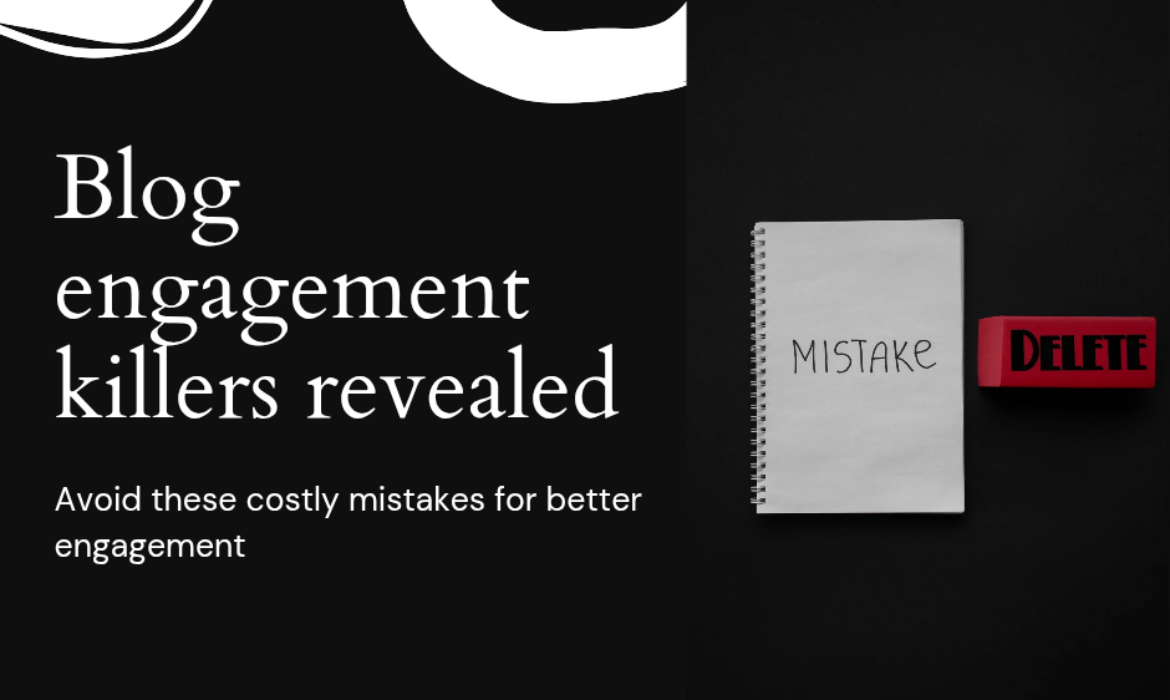081-4797-7173
Have you ever poured your heart into a blog post, only to find that no one seems to care? It’s frustrating, right? Blog engagement is the lifeline of a successful blog. When readers comment, share, or interact with your posts, it shows your content is striking a chord. But if your blog does not resonate with your audience, chances are you’re making some common mistakes without even realising it.
In this post, we’ll look into the top five mistakes that kill blog engagement and, more importantly, how you can avoid them. Whether you’re new to blogging or looking to revive a struggling blog, these tips will help you connect with your audience and keep them coming back for more. Below are the top mistakes:
Ignoring Your Target Audience
One of the most common blogging mistakes is writing without a clear understanding of your target audience. If your content is too broad or irrelevant, it simply won’t connect. Think about it; why would someone keep coming back to your blog if they don’t feel seen or understood?
Successful bloggers take the time to define who they are writing for. Are you targeting young entrepreneurs, parents, or tech enthusiasts? Once you know your audience, you can tailor your tone, topics, and even your examples to resonate with them.
Ignoring your audience often leads to generic or disconnected content that lacks impact. For instance, a blog aimed at new business owners would lose traction if it started diving into highly technical financial jargon. Why? Because it’s not aligned with the readers’ current knowledge level or interests.
To avoid this, do your research. Use tools like Google Analytics or audience surveys to learn more about your readers’ demographics and preferences. Additionally, engage with them in the comments or through social media to understand what they truly need and want.
Remember, blogging is a two-way street. It’s about creating value for your audience, not just talking about what interests you. Always ask yourself, “Is this something my readers will care about?” before publishing.
Inconsistent Posting Schedule
One of the biggest turn-offs for readers is an inconsistent posting schedule. Imagine following a blog that posts three articles in a week and then disappears for a month. It’s frustrating, right? Consistency builds trust, and readers want to know they can rely on you for fresh, valuable content regularly.
Now, this doesn’t mean you have to post daily or burn out trying to keep up. Instead, set a realistic schedule and stick to it. Whether it’s once a week, biweekly, or even monthly, the key is to stay consistent. Tools like content calendars can help you plan your posts in advance and stay organised.
Additionally, let your audience know what to expect. If they know you post every Wednesday, they’ll look forward to it. But if your blog feels unpredictable, they might lose interest and move on to something more dependable.
Neglecting SEO Practices
No matter how great your content is, it won’t matter much if people can’t find it. Ignoring SEO (Search Engine Optimisation) is like building in the middle of nowhere—no traffic, no visitors, no engagement.
SEO is a practical way to ensure your blog reaches the right audience. By neglecting SEO, you’re missing out on organic traffic, which could otherwise turn casual readers into loyal fans.
Start with keyword research. Tools like Google Keyword Planner or Ubersuggest can help you identify phrases your audience is searching for. Incorporate these naturally into your headlines, subheadings, and content without overstuffing.
Another key element of SEO is writing meta descriptions that summarise your content and entice users to click. Also, don’t overlook internal linking. Linking to your other posts not only improves navigation but signals to search engines that your content is interconnected and valuable.
And also don’t forget about mobile optimisation. More than half of web traffic comes from mobile devices. If your blog isn’t mobile-friendly, both readers and search engines will turn away.
Weak Call-to-Actions (CTAs)
A blog post without a clear call-to-action is like a conversation that ends awkwardly. Your readers may enjoy your content, but if you don’t guide them on what to do next, they’ll likely leave without taking any meaningful action.
CTAs are powerful tools for keeping readers engaged. Whether you want them to subscribe to your newsletter, leave a comment, or purchase a product, your CTAs must be clear, actionable, and enticing. A weak or vague CTA, like “Click here,” doesn’t spark interest or convey the benefit of taking that action.
To avoid this mistake, use CTAs that align with your goals. For example, if your goal is to build a community, try something like, “Join the conversation and share your thoughts in the comments.” For product promotion, a CTA such as, “Get 20% off your first purchase today” adds urgency and value.
Placement is also key. Don’t just put a CTA at the end of your post. Instead, put them naturally throughout your content where it feels relevant. And don’t overload readers with too many CTAs; it can feel pushy or overwhelming. Strong CTAs not only boost engagement but also encourage readers to take the next step in their journey with you.
Overloading Your Content with Ads
While monetising your blog with ads can generate income, overloading your content with them can quickly turn readers away. Imagine visiting a blog to learn something useful, only to be bombarded with pop-ups, banners, and autoplay videos. It’s distracting, frustrating, and unprofessional.
Excessive ads disrupt the reading experience and make your blog appear more focused on revenue than value. Readers might click away before engaging with your content, and worse, they may not return. Search engines like Google also penalise sites with intrusive ads, which can hurt your SEO ranking.
To avoid this mistake, strike a balance. Focus on delivering value first and monetisation second. Limit the number of ads on each page, and make sure they don’t interfere with your content. For example, avoid placing large banners in the middle of paragraphs or pop-ups that block the entire screen.
Consider other monetisation strategies, such as affiliate marketing, sponsored content, or selling digital products. These methods are often less intrusive and can align better with your audience’s interests.
Conclusion
Engaging readers is the lifeline of any successful blog. By avoiding common mistakes such as ignoring your audience, inconsistent posting, neglecting SEO, weak CTAs, and overwhelming ads, you can build a blog that truly resonates. Remember, the key is to put your readers first while maintaining quality and consistency.
If you’ve been struggling with blog engagement, it’s never too late to make changes. Start by evaluating your current content and identifying areas for improvement. Then, take small, actionable steps toward better practices. Have you faced any of these challenges while running your blog? Or do you have tips that worked wonders for you? Share your thoughts in the comments below, we’d love to hear from you.
0






